
Witham is a town in the county of Essex in the East of England, with a population of 25,353. It is part of the District of Braintree and is twinned with the town of Waldbröl, Germany. Witham stands between the city of Chelmsford and the City of Colchester, on the Roman road between the two. The River Brain runs through the town and joins the River Blackwater just outside.
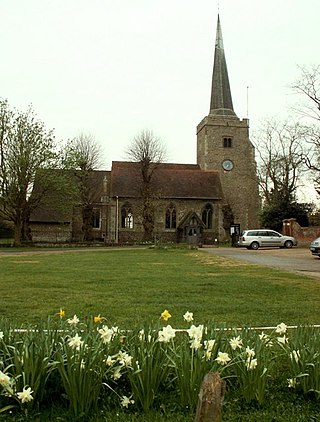
Danbury is a village in the City of Chelmsford district, in the county of Essex, England. It is located 33.5 miles (53.9 km) northeast of Charing Cross, London and has a population of 6,500. It is situated on a hill 367 feet (112 m) above sea level.
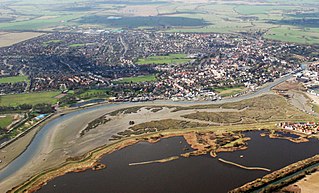
Maldon is a town and civil parish on the Blackwater estuary in Essex, England. It is the seat of the Maldon District and starting point of the Chelmer and Blackwater Navigation. It is known for Maldon Sea Salt which is produced in the area.

Rayleigh is a market town and civil parish in the Rochford District in Essex, England; it is located between Chelmsford and Southend-on-Sea, 32 miles (51 km) east of central London. It had a population of 32,150 at the census in 2011.

The village and civil parish of Writtle lies 1 mile (1.6 km) west of Chelmsford, Essex, England. It has a traditional village green complete with duck pond and a Norman church, and was once described as "one of the loveliest villages in England, with a ravishing variety of ancient cottages". The village is now home to Writtle University College, one of the UK's oldest and largest land-based colleges and a partner institution of the University of Essex, the grounds of which once housed a Royal hunting lodge, later the possession of the De Brus and De Bohun families.

Ingatestone is a village and former civil parish in Essex, England, with a population of 5,365 inhabitants according to the 2011 census. Just north lies the village of Fryerning, the two forming now the parish of Ingatestone and Fryerning. Ingatestone lies in the Metropolitan Green Belt 20 miles north-east of London. Its built-up area straddles the A12 trunk road and the Great Eastern Main Railway Line. It has become an affluent commuter village, seen as one of the UK's best places to live by the Sunday Times in 2020.

Brignall village is located in an elevated position adjacent to the River Greta, about 2 km upstream from Greta Bridge. The village is within the Teesdale district of south-west County Durham, England, the nearest town is the market town of Barnard Castle. The village is best known for the scenic valley section of the River Greta known as Brignall Banks, which is a Site of Special Scientific Interest.
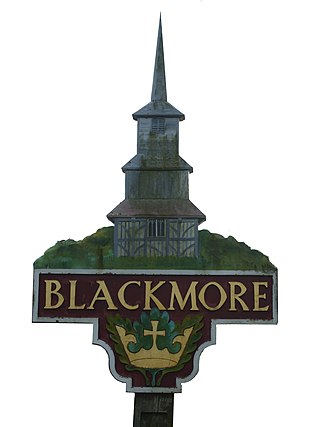
Blackmore is a village in Essex, England. It is located approximately 3 miles (5 km) east of Chipping Ongar and 4 miles (7 km) north of Brentwood. The village is in the parish of Blackmore, Hook End and Wyatts Green in the Brentwood district and the parliamentary constituency of Brentwood & Ongar. In 2018 it had an estimated population of 826.

The Rodings are a group of eight villages in the upper part of the River Roding and the west of Essex, England, the largest group in the country to bear a common name. The Rodings do not lie within a single district in the county; they are arranged around the tripoint of the administrative areas of Chelmsford, Uttlesford and Epping Forest. An alternative arcane name, linked to the Middle English Essex dialect, was The Roothings.

Black Notley is a village and civil parish in Essex, England. It is located approximately 1+1⁄2 miles (2.4 km) south of Braintree and is 9 miles (14 km) north-northeast from the county town of Chelmsford. According to the 2011 census including Young's End it had a population of 2,478.

Hullbridge is a village and civil parish in the Rochford district of Essex in England. Bordered to the north by the River Crouch, as well a distance from Hockley and Rayleigh. Hullbridge had a population of 6,527 at the Census 2011.

Witham is a parliamentary constituency in Essex represented by Priti Patel in the House of Commons of the UK Parliament since its 2010 creation. She is a Conservative who was Home Secretary from 24 July 2019 until her resignation on 5 September 2022 following the announcement of the results of the Conservative Party leadership contest.

Barstable was a Hundred in the English County of Essex. Both the hundred and the manor with the same name are mentioned in the Domesday Book of 1086. A number of parishes in the western part of the Barstable hundred are now in Thurrock.

Downham is a small village and former civil parish, now in the parish of South Hanningfield, in Essex, England. It is located approximately 7 miles (11 km) south of the county town of Chelmsford. The village is in the borough of Chelmsford and in the parliamentary constituency of Rayleigh. However, the closest two towns are Billericay, 3+1⁄2 miles (5.6 km) west-southwest, and Wickford, 2+1⁄4 miles (3.6 km) southeast. In 1931 the parish had a population of 833.

Braintree is a town and former civil parish in Essex, England. The principal settlement of Braintree District, it is located 10 miles northeast of Chelmsford, 35 miles (56 km) northwest of Southend-on-Sea, and 15 mi (24 km) west of Colchester. According to the 2021 Census, the town had a population of 43,492, while the urban area, which includes Great Notley, Rayne, Tye Green and High Garrett, had a population of 55,792.

Chignall St James is a village and former civil parish, now in the parish of Chignall, in the Chelmsford district in Essex, England. The village is situated 3½ miles northwest by west from the county town of Chelmsford. In 1881 the parish had a population of 224. On 24 March 1888 the parish was abolished to form Chignall, parts also went to Broomfield and Writtle.
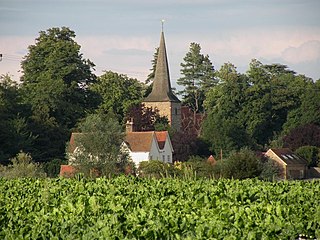
Fairstead is a village and civil parish in the Braintree district of Essex, England. Whilst isolated in a community of farming hamlets, the parish of Fairstead has close connections with Great Leighs and is 9.8 miles (15.8 km) from Chelmsford, Essex's county town.
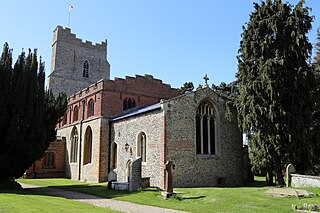
High Easter is a village and a civil parish in the Uttlesford district of Essex, England.

Rickling is a village and former civil parish, now in the parish of Quendon and Rickling, in the Uttlesford district of Essex, England. The village is situated approximately 6 miles (10 km) north from the town of Bishop's Stortford. Saffron Walden, at 5 miles (8 km), and the larger village of Newport, at 2 miles (3 km), lie to the north-east. In 1931 the parish had a population of 378.




















